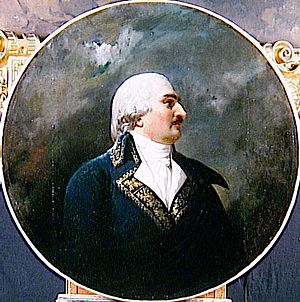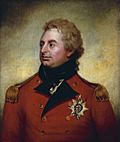Battle of Raismes (1793) facts for kids
Quick facts for kids Battle of Raismes |
|||||||
|---|---|---|---|---|---|---|---|
| Part of the Flanders campaign in the War of the First Coalition | |||||||
 French commander Marquis de Dampierre was fatally wounded late in the Battle of Raismes. |
|||||||
|
|||||||
| Belligerents | |||||||
| Commanders and leaders | |||||||
| Strength | |||||||
| 60,000 | 30,000 | ||||||
| Casualties and losses | |||||||
| 600–870 | 2,100 | ||||||
The Battle of Raismes, also known as the Battle of Condé or St. Amand, happened on May 8–9, 1793. It was a clash between the French Republican army and the Allied Coalition forces. The French, led by Auguste Marie Henri Picot de Dampierre, tried to break the siege of the nearby town of Condé. However, they were defeated by the Coalition army, commanded by Prince Josias of Saxe-Coburg-Saalfeld. This battle was part of the Flanders Campaign during the larger War of the First Coalition. After intense fighting, the French pushed back a Prussian force, but British soldiers arrived and helped the Allies. Dampierre was badly hurt while leading a final attack. The Allies took back the lost ground two days later.
Contents
Before the Battle of Raismes
French Army Changes
In March 1793, the Allied forces defeated the French at the Battle of Neerwinden. This forced the French armies to retreat from the Austrian Netherlands and the Dutch Republic. They regrouped behind the French border. The French commander, Charles François Dumouriez, then tried to use his army to overthrow the French government, called the National Convention (a kind of parliament). His plan failed, and Dumouriez joined the Austrian side on April 5.
Because of Dumouriez's actions, French generals were now viewed with suspicion. The government, especially the powerful Jacobin group, watched them closely. If a general wasn't seen as loyal enough, they could face serious trouble.
Dampierre Takes Command
Auguste Marie Henri Picot de Dampierre was chosen to lead the French armies in Flanders. He had refused to join Dumouriez's plot. His forces were split into the Army of the North (his main army) and the Army of the Ardennes (a smaller force). Dampierre was known for admiring the Prussian army. He even dressed and acted like a Prussian soldier!
Allied Plans and Strengths
On April 8, 1793, the Allied army began to surround the French fortress of Condé-sur-l'Escaut. The Allied commander, Prince Coburg, planned to have about 92,000 soldiers by mid-May. More troops would arrive later, bringing his total to over 100,000. This army included soldiers from Austria, Britain, Prussia, the Netherlands, Hanover, and Hesse.
Coburg was a good commander, but he was also slow and careful. He used a "cordon system," which meant spreading his army out widely. This covered many roads but also made his forces less concentrated. His army was much larger and better trained than the French army.
French Positions
By April 15, Dampierre's army was near Valenciennes. He had about 10,000 soldiers on his right side near Maubeuge and 10,000 on his left near Cassel. His main force of 30,000 was at Famars. Other troops were spread out or guarding important towns like Dunkirk and Lille.
Dampierre wanted to rest his soldiers and wait for more troops. However, the government representatives pushed him to attack. They accused him of not being enthusiastic enough for the revolution. Dampierre felt pressured to act.
Allied Positions
On April 23, Coburg's army was positioned around Condé. His right side had Dutch and Imperial troops. The Duke of York led British and Austro-Prussian soldiers near Tournai. Alexander von Knobelsdorff commanded 8,000 Prussians at Maulde, Lecelles, and Saint-Amand. Count Clerfayt had 12,000 men at Vicoigne and Raismes, covering the siege of Condé from the south. Coburg's main army was south of Condé. In total, Coburg had about 60,000 soldiers.
The Allied army was stronger than the French. Their positions were well-defended. However, the Scheldt River split their army, and their defenses were spread out too much. Also, each country's supply lines went in different directions.
The Battle Begins
First Attack on May 1
Prince Coburg allowed Dampierre to attack first, even though the Allies had more soldiers. On May 1, the French launched an attack along the entire Allied front. Dampierre even used soldiers from other French armies to make his attack stronger.
East of the Scheldt River, one French group pushed back some Austrian outposts. But Austrian reinforcements arrived and forced the French back. Another French group panicked when they saw a large force of Austrian cavalry and fled.
West of the Scheldt, Count Clerfayt easily stopped a French attack. On the French left side, a group led by La Marlière managed to capture Saint-Amand. They pushed back 4,000 Prussian defenders. The Duke of York brought British Guards to help stop this attack. Since La Marlière didn't know how the other French attacks were going, he pulled his troops back. The French lost about 2,000 men and some cannons in this first attempt.
Main Battle on May 8
Even after the first failure, the government representatives insisted that Dampierre try again to save Condé. The May 1 attack showed that the Allied right side was too weak. So, Coburg moved his right-side units closer to the center. He assigned the Duke of York to defend Maulde.
This time, Dampierre focused his main attack on Clerfayt at Raismes and the Duke of York at Maulde and Saint-Amand. On the French left, La Marlière attacked in three groups. Dampierre himself led a direct attack from Anzin against Raismes and Vicoigne. After being pushed back four times, he finally captured a position at Raismes, but not the village itself.
French soldiers captured part of Raismes, but Clerfayt brought in fresh troops, and the French were forced out. Dampierre then led eight battalions forward. Sadly, a cannonball hit his leg, and he was gravely wounded. Lamarche took command. Seeing that the soldiers were losing hope after Dampierre fell, he ordered a retreat.
La Marlière's group took Saint-Amand, which the Prussians had left. One of La Marlière's divisions crossed the Scarpe River and moved secretly through the Forest of Vicoigne. They set up cannons that could fire on Vicoigne village and built a small fort (a redoubt). This fort threatened to cut off the link between Clerfayt's and Knobelsdorff's forces.
Earlier, the Duke of York had moved the British Guards to Nivelle, north of Saint-Amand, to support Knobelsdorff. At noon, the Duke of York sent the 1st, 2nd, and 3rd Foot Guards towards the fighting.
A Prussian and an Austrian battalion had already been defeated by the French cannons in the woods. The Duke of York arrived with the British Guards at 5:00 pm. The area was heavily wooded, so the Duke couldn't see clearly. Knobelsdorff ordered the 2nd British Guards battalion into the woods without telling them about the French defenses. This was the first time the Guards fought against the French Republic.
Lieutenant-Colonel Lowther Pennington led his men into the woods and pushed the French back to their trenches. However, when they went beyond the trees, they faced heavy gunfire from the trenches. The Duke of York later wrote that Pennington attacked without orders and his men were hit by cannon fire, causing many casualties. The Guards suffered over 70 casualties and, realizing they had no Prussian support, fell back. When La Marlière saw the red-coated British soldiers, he thought the Allies had received many reinforcements and stopped his attack.
Aftermath of the Battle
On May 9, Clerfayt and Knobelsdorff attacked the new French defenses and captured 600 soldiers. The French cannons had been moved away during the night, so they escaped. Dampierre died from his wounds on the same day and was buried at the Camp of Famars. Lamarche took over command of the Army of the North, and Kilmaine commanded the Army of the Ardennes. On May 10, La Marlière pulled his troops back to Lille, and the Allies did not chase them.
Reports on casualties varied. One officer reported nearly 4,000 French killed and wounded, while the Austrians lost 500 and Prussians 300. The Coldstream Guards regiment lost 63 to 73 soldiers. Historian John Fortescue reported combined Austrian and Prussian losses of 800 for May 8–9. For May 8 alone, Digby Smith listed 600 Allied casualties out of 60,000 troops and 1,500 French casualties out of 30,000 engaged.
The heavy British losses caused some tension among the Allies. Both the Duke of York and Knobelsdorff faced blame. Knobelsdorff was accused of not warning the British about the French defenses in the forest. The Duke of York's chief-of-staff blamed Pennington, who was known for being impulsive.
Dampierre's death likely saved him from being punished by the French government. Even though his soldiers praised him, he was later accused of being a traitor in Paris. La Marlière also came under suspicion and faced severe consequences a few months later. Condé finally surrendered on July 12. After the battle, Coburg received more British and Hanoverian troops. He then began planning to surround Valenciennes, which led to the Battle of Famars.




